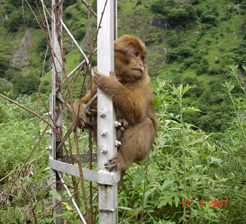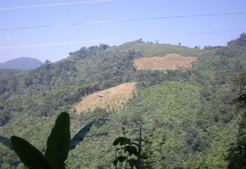Amidst the Greens of Arunachal:
Weapons of Mass Destruction, Distraction!
-Govind Singh
Located in the North-eastern most extremity of India, the state of Arunachal Pradesh is known for its rich biodiversity and as a birding hotspot. It
is a land of lush green forests, deep river valleys, and beautiful plateaus and is also one of the most sparsely populated states of India. But for its geographic location and other political factors, the state would have been an ideal eco-tourism destination
and an ultimate getaway for the rest of India. For the same reason, the state is also least explored when it comes to biodiversity (and even the cultural diversity).
Such is the lack of information about the biodiversity of Arunachal Pradesh that the
Arunachal Macaque (Macaca munzala) - a species of monkey already known to the native people of Arunachal (especially to the Monpas of Tawang and the tribes of the West Kameng District) as Munzala or the “monkey of the
deep forest”, remained unknown to scientists and biologists till it was “discovered” in 2004. The so called “discovery” was waiting to happen and it was after more than a hundred years that a new species of macaque was discovered (the last recent discovery
being the Indonesian Pagai Island Macaque in 1903).

Arunachal Macaque in Tawang
Further, in November 2007, a team comprising two herpatologists and a wildlife documentary filmmaker,
claimed to have found a unique species of pit viper snake from the remote Sango area in Papum Pare district of Arunachal Pradesh. The finding created a flutter among the country’s herpetologists. Here too, the animal was already well known to the native
Nyishi tribesmen of the area. Barta, as the natives knew the six-foot- something reptile, in fact has been the most-feared creature among the tribes in Arunachal Pradesh and according to Nyishi folklore, the sighting of a
barta is considered to be a bad omen. Prior to this, a new bird species, the Bugun Liocichla (Liocichl
bugunorum), was reportedly discovered and described from the state.
These findings alerted both scientists and biologists who now became fully aware of the biodiversity potential of the state and scores of experts, amateur
bird watchers, biologists and wildlife professionals have frequented and are still frequenting the state to explore and investigate. At the same time, the state of Arunachal Pradesh is also the one with the greatest hydropower potential of over 50,000 megawatt.
Since the Central Government has shown key interest in harnessing this potential, the state government has been making proactive effort to woo private players to set up power projects in the state. This is further bringing in more scientific experts in to
the state, for carrying out pre-feasibility studies of such projects.
However, this recent foray of scientific expertise in the state may already be a little too late. And the state may have already lost a considerable
proportion of its biodiversity and species composition. Two major factors responsible for the same, can well be termed as the weapon of mass destruction and weapon of/for mass distraction!

An Idu Mishmi tribalfolk from District Anjaw wearing a Dau
All through the state of Arunachal, one observes the native people wearing a long dagger, around their neck that hangs down along their waist. The dagger
is kept in a sheath crafted out of bamboo and is known as ‘dau.’ For the biodiversity in the state, it is nothing less than a weapon of mass destruction. Contrary to what many may think, wearing a
dau is a matter of self-pride and a symbol of social service. The thick vegetation cover in the state and the occurrence of a large number of wild animals ensures that anyone traveling needs to keep such a weapon with her/himself. And for those who do
not, others offer their services of making way in a dense forest, etc. by cutting down herbs and shrubs and killing a snake, etc. that may fall in way. The wearing of
dau by people of all tribes in the state indicates that it has more defensive importance than cultural. It’s a weapon of the masses and clearing of a disturbed stretch of forest using a
dau hampers biodiversity in ways more than one.
However, more dangerous than this weapon of mass destruction is a weapon of/for mass distraction –
Jhumming, shifting cultivation or the swidden agriculture, practiced in several parts of the state. While traveling through the state, one can observe large patches of cleared land amidst a thick forest. This is a result of
jhum cultivation wherein a patch of forest is selected and burnt down to carry out agricultural activity on the cleared ground. After cultivating for a few years, the patch is left to replenish and a new patch awaits the same fate. The cleared patches
all across the mountains are like an eye sore and would distract anybody traversing through the state.

Patches of forest resulting from Jhum cultivation
Jhumming is known to be a primary cause of deforestation and research is on to promote alternative sustainable methods of cultivation in the state. Though
a method followed in the state for the past several years, the ever increasing population has now made the system unsustainable. Adding to that, the fear of a changing climate, jhumming is now seen as a wasteful method and a threat to global environment. Once
the patch of land is left to replenish itself, the species of bamboo, etc. that immediately grow result in the raising of a secondary forest. The cleared land is also an invitation to invasive plants that are increasingly spreading in the state. These are
also impacting the native wildlife, which is constantly on the decline.
Recent international political pressure and the demand for development from within the state has called in for rapid measures to improve the state’s
infrastructure and explore the potential of developmental tools such as eco-tourism. However, it should be ensured that every policy and plan made for the state is well researched and is based on the principles of sustainable development. While
ad hoc development in other parts of the country could sustain to some extent, a similar mistake in Arunachal Pradesh could be devastating for the state’s fragile ecosystem and result in more harm than gains.
(Photographs by Govind Singh)